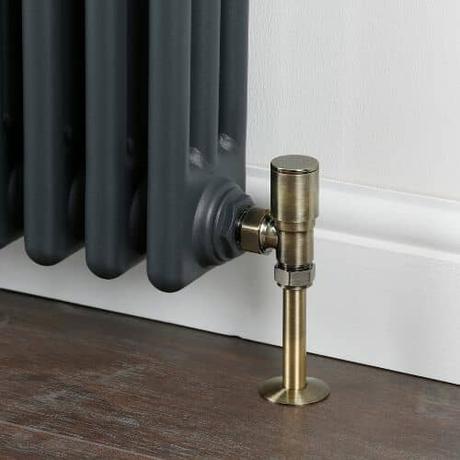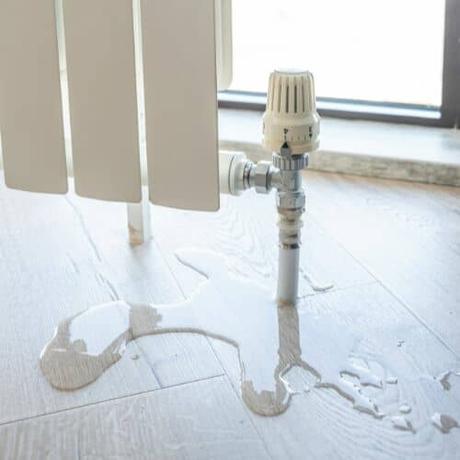Knowing how to turn a radiator off is a quick and easy job that could save you money and energy. Something we all need right about now! You might also need to turn a radiator off to complete a radiator maintenance job or fix a leak. Follow these simple steps to turn off your radiator.
How to turn off a radiator with a thermostatic valve
Most radiators these days have thermostatic radiator valves (TRVs). This is because they give you greater control over your room temperature and heat your home more efficiently than other valves.
You will know if you have thermostatic valves because the top of the valve on one side of the radiator will usually have numbers 0 to 5 on the dial to adjust the heat.
However, there are other thermostatic valve designs that do not feature the numbered dial but still work in the same way, like our Windsor valves for example.
Step 1: Turn the valve down to zero
If your thermostatic valve has numbers on it, turn the valve head down to the zero position to turn the radiator off. If your valve doesn’t have numbers, just turn it clockwise all the way until it won’t turn anymore and the valves are closed. This will stop the radiator from transferring any heat into the room through convection.
Step 2: Turn the lockshield valve off
Complete step one to turn the radiator off to stop it from heating up the room when the heating is on. But if you want to stop any new water from entering the radiator you will also need to turn the lockshield valve off. This is called isolating the radiator.
To do this, go to the valve on the other side of the TRV and remove the cap from the top. This will reveal a metal spindle which is the actual lockshield valve. Turn the valve clockwise all the way with a pair of pliers to turn the radiator off.
How to turn off a radiator without a thermostatic valve
Turning off a radiator without a thermostatic valve is exactly the same method as with a TRV. Find the valve on the opposite side of the lockshield valve. This is known as a manual valve.
Twist the manual valve clockwise until it doesn’t turn any further. This will turn the radiator off and stop it from heating up the room.
The lockshield valve will also be the same in a pair of manual or thermostatic valves. So if you want to isolate the radiator, repeat step 2 from the previous method.
How to turn off a towel radiator
Just like radiators, towel rails have either a manual or thermostatic valve on one side and a lockshield valve on the other side. All you have to do to turn off a towel radiator is to twist the manual or thermostatic valve clockwise all the way. This will turn your bathroom radiator or heated towel rail off.

How to turn off a radiator when the thermostat is broken
The last thing you want is for your radiator to blast out heat when you don’t want it to. Especially if the barmy British weather has a sudden heatwave! If this happens even when you turn down your thermostatic valve to the 0 position it probably means that the thermostat is broken and the valve will need to be replaced.
But how do you turn the radiator off and stop yourself from overheating when the thermostat is broken? Go to the other end of the radiator to the lockshield valve. Remove the plastic cap from the lockshield valve. Use a small spanner to turn the spindle clockwise.
Keep turning the spindle until you can’t turn it anymore. This should turn off the radiator and allow it to cool down. Also, remember to note down how many turns you are had to make. You will need to turn it back the same number of times in order to balance the radiator when you want it back on. Not sure what balancing means? Take a look at our radiator balancing guide.
How to turn off a radiator when it leaks
If you notice that one of your radiators is leaking, it is important that you turn it off as soon as you can. Particularly if the heating is on and very hot water is escaping into your home! Turning the radiator off will prevent any water damage to your flooring or furniture, and also prevent any dangers of scalding.
If the leak looks like it is coming from the radiator valve, turning the valve off clockwise may be enough to fix the immediate problem. You should then replace the radiator valve. However, if the leak is coming from a corroded pipe or hole in your radiator, you may need to drain the radiator to stop the leak and contact a Gas Safe Registered engineer to assess the issue.

Is it OK to turn off individual radiators?
It is perfectly ok to turn off individual radiators in different rooms. When you turn off a single radiator, you are stopping the boiler from sending hot water to that radiator. This can actually improve your energy efficiency and lower your costs by not heating unused rooms. Just remember to close the doors of the rooms where the radiators are completely turned off. This will prevent any cold air from escaping and cooling down the rooms you want to keep warm!
Got another heating question?
As you know, we are the experts when it comes to home heating. We know our stuff and we are always here to help you out with our top tips and advice. So if you have any other heating questions, we have probably answered them in our FAQs. You’re welcome!

